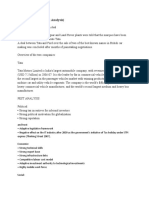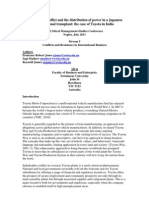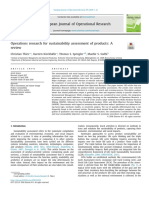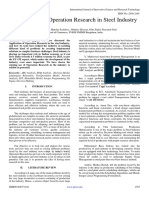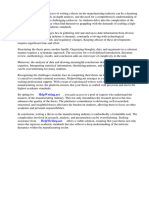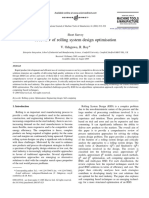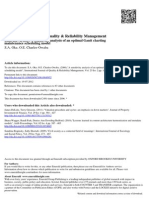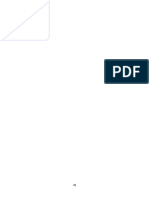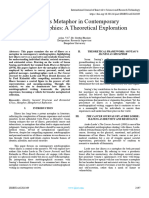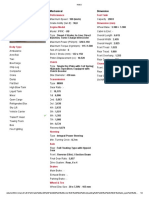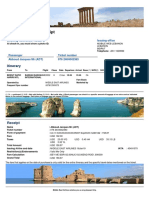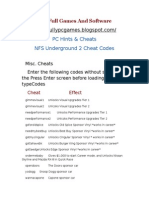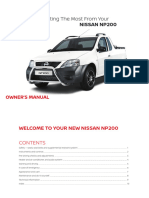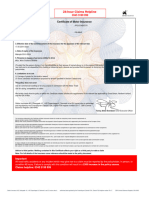Application of Operations Research in Steel Industry
Application of Operations Research in Steel Industry
Copyright
Available Formats
Share this document
Did you find this document useful?
Is this content inappropriate?
Report this DocumentCopyright:
Available Formats
Application of Operations Research in Steel Industry
Application of Operations Research in Steel Industry
Copyright:
Available Formats
Volume 6, Issue 10, October – 2021 International Journal of Innovative Science and Research Technology
ISSN No:-2456-2165
Application of Operations Research in Steel Industry
1
Ishika Sheth, 2Garvit Chhabra, 3Gaurav Agarwal, 4Harsh Raka, 5Iccha Saraf
Student, Anil Surendra School of Commerce, NMIMS Mumbai, India
Abstract:- In this paper, we have discussed the use of In this research paper the application of Operations
Operations Research in the steel industry and how they Research in the Steel industry has been discussed in the
are used to tackle the production process problems, cost following ways:
minimization problems, and transportation problems. 1. Transportation problems using VAM and the Simplex
Operations research has been used for decades to optimize method have been used in optimizing the cost involved in
business models and processes. The estimated demand for transporting finished products to and fro from the
steel has risen by 7.2% in the year 2020 and experts see processing plants.
incessant growth for the Indian economy. Domestic 2. Moreover, the problem of scheduling of the multiple
manufacturers will intensively require to optimize their trucks arriving at the warehouse has been tackled using the
production process to keep up with the demand. Based on Queuing theory and Internet+.
mathematical and statistical calculations, the paper aims 3. Assignment problem helps in allocating the best route for
to optimize the logical and systematic processes and transporting different steel products to different
approaches in one of the fastest-growing industries in warehouses to obtain optimality in terms of cost and time
India. involved.
4. The Just in Time theory of Inventory Management is used
Keywords:- Operations Research, Steel Industry, Simplex to schedule what quantity of raw material is required at
Method, Transportation by VAM, Optimizing, Queuing what time. This helps in giving the business a competitive
Theory, Just-in-Time Management. edge by reducing costs and uninterrupted production.
5. The structure of a factory has a great impact on its
I. INTRODUCTION efficiency. The research paper includes an optimal floor
plan layout to productively utilise all resources of space,
Steel is one of the major foundations for the machine, and manpower.
development of industries in the international economy.
Industries like defense, transportation, energy, aeronautics, II. LITERATURE REVIEW
construction, etc. all have major requirements of steel. This
industry has the potential to back the national economy of The steel industry faces numerous problems while
countries. China is the leading producer of steel (60%) in the optimizing their processes. This is mainly due to the size of
world. Countries like Japan, the USA, and India have the next their capital and the time required to process the metal. These
biggest share of the production. are the fixed costs of the business that can be reduced
sparsely. However, the variables costs involved can be
Operations Research (OR) is the process of converting manipulated and cut down more effectively. For example, the
statistics, figures, and data into improved decision making. It fee for the carriage of goods incoming and outgoing can be
comprises the application of various scientific and controlled and reduced. In this paper we have discussed some
mathematical methods to solve challenging problems. OR has Operation research theories that can be implemented to curb
been used in several situations in the past. British scientists these costs.
used OR to teach the militants about the newly developed
radar to locate enemy aircraft. It was the start of the use of OR Das et al. take into consideration the fixed charge (like
in military services in Britain and many other countries. After cost of renting a vehicle, landing fees in an airport, setup of
World War II, several British Operations Research workers machines in manufacturing environment etc.) capacitated in a
moved to the National Coal Board, electricity and transport nonlinear transportation problem with non-linear objective
boards, and also to the Iron and Steel Research Associations. functions and linear constraints. Thereby establishing
indigenous optimum conditions for the given problem and
OR in today's world is a bit different, more accurate, and also establishing an algorithm for solving the transportation
very challenging. This is due to the developed techniques, problem.
type of data collection, new problems, and unique business
situations. Operations Research has helped many businesses By this research, we can solve non-linear transport
to solve different problems such as reduce costs, increase issues by taking price reductions, price breaks into
efficiency, etc. Costs like transportation, inventory storing and consideration, which would help identify more accurate costs
maintenance can be reduced by OR. Various OR techniques of transport and eventually lower them by the choosing of the
like Transportation Problems, Linear Programming, Interior optimum solution from the available alternatives. (Das, 2013)
Point Method, etc. help minimize these costs. It also aids
better machinery setup and provides improved inventory
management.
IJISRT21OCT225 www.ijisrt.com 252
Volume 6, Issue 10, October – 2021 International Journal of Innovative Science and Research Technology
ISSN No:-2456-2165
Furthermore, Jha et al., Operations Research the Albert David Company, which functions with 3 plants
Applications in Steel Industry use replacement theory for across India with 14 depots. In an integrated steel plant, the
transportation and operations research optimization. The factory has many aspects and features. From loading and
transportation model is advantageous to the steel plant to unloading from docks of steel coils to processing and slitting
develop a strategic plan to reduce transportation costs. The machines. In specialized and large-scale businesses, they have
replacement cost theory assists a steel company in replacing a their in-house processors. They use tech-savvy machines such
truck that transports raw materials to improve efficiency. as a slitting machine, a decoiler, and a shearing machine. For
Because of the deteriorating property, failure or breakdown of optimal usage of the capital, the companies use planning and
certain equipment, the replacement theory is required. This research. Sometimes it is easy to work up from an infeasible
would help in providing solutions in terms of cost reduction, solution to a relevant one. (Sharma, 2012)
selecting the most relevant solution for the given problems
and finally executing it. He offers a contingent plan on how to Another method used is the Big M method. The process
best execute it in case the problem goes awry and the is known as the "common sense approach" too. It aims to
company has to find a substitute to help them commute their make the artificial variables in the main objective function
goods. (Jha, 2018) extremely unprofitable, this pseudo cost makes any real
outcome far more feasible, as compared to the original
Ascertaining the utmost significance of the utility of impossible feasible solution. The inflating of values can be
transportation problems across sectors, the above research understood as charging a penalty, a penalty so exorbitant that
papers used various methods to minimize the transportation it cannot be a part of the ultimate solution. If the objective
costs, the applicability of which has substantial significance in function (Z) is to be minimized, then a very large positive
steel industry. On a mathematically experimental basis, Rekha price (penalty, M) is assigned to each artificial variable and if
Joshi, a researcher, computed the Transportation Problem Z is to be minimized, then a very large negative price is to be
using North West Corner Method (NWCM), Least Cost assigned. The penalty will be designated by +M for
Method (LCM), Vogel Approximation Method (VAM), and minimization problem and by –M for a maximization problem
Modified Distribution (MODI) method for three variable and also M>0.
problems to determine the most economical and optimal
routes of transportation. Other papers employed VAM to Dutta and Fourer, Mihailor, who focuses on 34 papers,
compute the initial solution to minimize the transportation provides an outline of how linear programming models in
cost, following which, the MODI method was employed to steel plants can be used. Gercuk focused on composition
calculate the improved optimal solution further scaled down charges, optimal equipment loading, and equipment
the cost. Ablordeppey, illustrates transportation problems of transportation in a non-mathematical overview of linear
the brewery using quantitative manager in the programming and some of its applications. The economical
paper. (Ablordeppey, 2012) (Joshi, 2013) use of machines and materials is the maximisation of many.
The economical use of machines and materials is the
In the paper by Askerbeyli, a case study based on a maximisation of many variables. An example of the said
specific steel company in Turkey is used to minimize the cost variables would be market prices, the grade of steel, and the
of transportation of various steel products to different regions processes it has to go through. While considering the scrap
with the help of Operation Research techniques. These value of steel, the work of Fabian (1958), who designed a cost
methods proved to be highly efficient across different minimisation in the linear programming model and that model
industries while numerically concluding the MODI method as had four subparts. 1. Iron-making. 2. Steelmaking. 3. for shop
the best way to solve transportation problems, pertaining to its loading for rolling operations. 4. Finishing operations.
ease in computation of the optimal solution in lesser time.
(Askerbeyli, 2020) The models of various stages of production are
interconnected to form a "Master Model" of an integrated
Zhang et al. in his research paper highlights the steel plant. (Fabian., 1958) (Goutam Dutta), (Fourer, 1997),
ineffective scheduling of the inbound and outbound (Gercuk, 1961).
operations of steel plates in shipyards. He points out the high
costs involved due to inefficiency and formulates a method to Having referenced multiple research papers, we focus on
find proper storage locations during the in-steel stage thereby elaborating on new and efficient ways a steel processing plant
reducing costs during the steel-out process. The ‘Greedy can optimize their operations and maximise its profit. We
Algorithm’ is a simple algorithm based on the concept of consider better ways of managing inventory, faster ways to
intuition used for optimizing problems. As it tries to find the transport their materials and coils, optimal use of machines
overall best solution to the problem, the algorithm takes the such as slitting and decoiling machines and more. We have
best decision at each phase. Zhang et al has worked on the understood the above methods and will use operations
data of an actual shipyard to validate the effectiveness of the research to enunciate further how to mathematically optimize
‘Greedy Algorithm’ used. (Zhang, 2013) a business.
Sharma et al., suggested that the transportation problem
be solved with the help of dual simplex. and two-phase
method. This method starts with an infeasible solution which
is optimal and works towards feasibility. The author refers to
IJISRT21OCT225 www.ijisrt.com 253
Volume 6, Issue 10, October – 2021 International Journal of Innovative Science and Research Technology
ISSN No:-2456-2165
III. APPLICATION OF OPERATION RESEARCH IN solution. Because the initial basic viable solution provided by
STEEL INDUSTRY this method is either ideal or extremely close to the optimal
solution, it is chosen above the NWCM and LCM.
Objective
The objective is to understand the use of few OR Transportation problem by VAM can be used to
methods like Transportation Problems using VAM and minimize the transportation cost in the iron and steel industry.
Simplex Method to minimize transportation costs in the Iron In paper, they used a problem-based in Turkey to minimize
and Steel Industry. A transportation problem is a form of the transportation cost by using VAM. There were 6 products
linear programming problem in which the object is to reduce which were to be transported to 6 regions according to the
the cost of transporting a product from multiple sources to demand of each region. The problem was solved using the
various destinations. demand and supply quantities of each product supplied to
each region, and the transportation cost of each route. Using
Transportation by VAM VAM the best routes were selected and the optimal solution
The Vogel approximation method is an iterative was determined. The total transportation cost was minimized.
procedure for calculating a basic feasible transportation (TC=3514619)
Table 1: Step 1, Verify if AD = AS
Table 2: Step 2, IBFS by VAM
Step 3: Calculate Total Cost graphics programming language and a free Software
Total Cost: (51 × 2539) + (85 × 901) + (17 × 14000) + environment. It is used to create statistical software and
(65 × 10958) + (43 × 9000) + (85 × 5099) + (70 × analyse data. Through that software, the number of units
4000) + (51 × 21904) + (7 × 6608) + (7 × 8000) + supplied to different locations using various routes has been
(7 × 5500) = 𝟑𝟓𝟏𝟒𝟔𝟏𝟗. established and the optimal solution has been found. The TC
using the Simplex Method was TC=3514619. Using both the
The Simplex Method Transportation problem by VAM and the Simplex Method the
The Simplex Method is the first solution algorithm for TC was found to be the same, which was TC=3514619.
linear programming problems that were created. It is a method (Askerbeyli, 2020)
for solving a set of linear equations quickly and efficiently.
The simplex method moves from one extreme point to one of It is suggested to minimize transportation cost in the
its neighbouring extreme points. The simplex algorithm is steel industry using TP by VAM method over the SIMPLEX
commonly used to determine the best combination of method. The VAM method is easy to use and the solution is
ingredients at the lowest cost (the goal). close to the optimal solution. The SIMPLEX method has a
technique that is very complicated, difficult to adopt, and has
Simplex Method is a means to find the optimal solution too many steps, therefore it is hard to learn and perform.
of an optimization problem in this case being the high VAM is systematic, takes less time, and gives the best
transportation cost of finished products from the steel factory. possible cost of every route. Therefore, VAM is preferred
In the paper, the programming language R has been used to over the SIMPLEX method.
facilitate the Simplex algorithm. R is a statistical computing,
IJISRT21OCT225 www.ijisrt.com 254
Volume 6, Issue 10, October – 2021 International Journal of Innovative Science and Research Technology
ISSN No:-2456-2165
Queuing Theory Using Assignment Problem for optimizing transportation
Several times, due to a lack of scheduling, multiple Assignment Problem helps in optimizing the
trucks arrive at the same warehouse at the same time, and one transportation of the Iron and Steel Industry by minimizing
of them must wait. There are times when the time between the cost and time involved. Here, A to F represents the
two trucks arrivals is so long that the warehouse and loading warehouses involved in the transportation. There are 6
equipment sit idle. products involved in the problem. The numbers in the cell
represent the cost of transportation.
The goal of selecting optimal routes and timetables is to
reduce truck operating costs while carrying all units of steel to This is the original cost matrix:
the designated destination within the specified time period. To
arrive at the best scheduling solution, all viable schedules for Table 3: Original cost matrix
each warehouse and route are obtained, and the least costly A B C D E F
schedules for each truck is picked. Product 1 51 65 43 85 70 17
This theory describes a system for predicting the optimal Product 2 51 65 43 85 70 17
number of truck loading/unloading stations needed in a
factory site to satisfy future traffic levels. The technique is Product 3 51 65 43 85 70 17
based on the assumption that the number of loading/unloading
stations may be expanded as long as the marginal cost of Product 4 41 55 43 75 60 7
stations (building and maintenance) is less than the waiting Product 5 41 55 43 75 60 7
truck delay charges. The number of waiting trucks and
average truck delays was calculated using the "queuing Product 6 41 55 43 75 60 7
hypothesis."
We subtract the row minimum from each row:
The queuing theory is used in conjunction with
warehouse infrastructure and activities to calculate the
Table 4: Subtract row minima
optimal number of loading stations at a warehouse. The goal
A B C D E F
is to avoid over-and under-building by accident. The station
movements should be evaluated first in this technique. The Product 1 34 48 26 68 53 0 (17)
waiting time of trucks outside the loading station and in line is
estimated using the queuing model in question. Cost estimate Product 2 34 48 26 68 53 0 (17)
studies, including station and waiting truck costs, are
conducted for economic reasons. Lastly, the optimum number Product 3 34 48 26 68 53 0 (17)
of loading stations is decided to obtain the minimal cost.
Product 4 34 48 36 68 53 0 (7)
The amount of time a truck must wait at the loading
warehouse is determined by how many other trucks must use Product 5 34 48 36 68 53 0 (7)
the same warehouse, how many trucks are prepared for
loading, and how quickly a truck can load once it arrives at Product 6 34 48 36 68 53 0 (7)
the factory. The length of time the truck is engaged with
loading/unloading is determined by the truck's type and size,
the warehouse’s capabilities, and the type of ore to be
loaded/unloaded. We subtract the column minimum from each column:
Internet+ Table 5: Subtract column minima
Internet + is used to integrate the use of Internet and A B C D E F
traditional industries to improve production factors and Product
0 0 0 0 0 0
modernise businesses using Internet information technology. 1
As a result, this study proposes to employ "Internet +" Product
0 0 0 0 0 0
technology to create a logistics information platform for the 2
warehouses where the iron/steel is dispatched, where the Product
0 0 0 0 0 0
container central warehouse dispatcher and trucks may 3
exchange information. According to the volume and time Product
0 0 10 0 0 0
requirements of container trucks, the status of loading and 4
unloading equipment, to reserve the truck's arrival time, Product
0 0 10 0 0 0
which not only guarantees the quantity of container demand 5
for collection and distribution operations, but also effectively Product
0 0 10 0 0 0
reduces truck waiting time in the factory, and realizes the 6
maximum efficiency of seamlessness. On the basis of sharing (34) (48) (26) (68) (53)
the truck's anticipated arrival time, a logistical information
platform is developed. (Qi, 2020)
IJISRT21OCT225 www.ijisrt.com 255
Volume 6, Issue 10, October – 2021 International Journal of Innovative Science and Research Technology
ISSN No:-2456-2165
There are 6 lines required to cover all zeros: The optimal value equals 301.
Table 6: Cover all zeros with lines Costs of Inventory Management
A B C D E F Inventory management is a crucial aspect of any
Product business, inadequately managing inventory could lead to
0 0 0 0 0 0 X higher storage costs, higher carriage costs, and could also lead
1
Product to lost opportunities that might come a business’ way. The
0 0 0 0 0 0 X costs associated with keeping the inventory account for
2
Product almost a quarter of the value of the inventory. Applying
0 0 0 0 0 0 X operations research techniques for inventory management
3
Product would give a business a comparative edge over its
0 0 10 0 0 0 X contemporaries.
4
Product
0 0 10 0 0 0 X What Is Just-in-Time (JIT) in Inventory Management?
5
Product JIT, is a system that ensures that the business is working
0 0 10 0 0 0 X closely with its suppliers, so that raw materials are transported
6
at the scheduled time, hence production remains unhindered.
Because there are 6 lines required, the zeros cover an optimal The goal is to have the minimum amount of inventory on
assignment: hand to meet demand. The said method involves a detailed
understanding of what to order, the quantity to order, and
Table 7: Optimal assignment when to order. If one master this, they may be able to
A B C D E F optimize the costs related to buying and storing without
interrupting the flow of the business.
Product
0 0 0 0 0 0
1
Different methods to handle Inventory Management
Product
0 0 0 0 0 0 Having a system for counting the inventory is a
2
prerequisite for ordering inventory promptly. The 'Periodic
Product
0 0 0 0 0 0 System', as the name suggests, is checking on the inventory at
3
regular intervals. It might be daily, weekly, or monthly.
Product However, this isn't very effective for JIT.
0 0 10 0 0 0
4
Product Another method would be the two-bin system, its simple
0 0 10 0 0 0
5 method, there’s two containers or two racks of raw material
Product and as soon as the first bin is empty, the order is placed for the
0 0 10 0 0 0
6 next.
This corresponds to the following optimal assignment in the Perpetual Inventory Method is a system that keeps track
original cost matrix: of removals of inventory continuously thus monitoring the
current levels of each item, an example would be bank
Table 8: Optimal assignment in original cost matrix account balance, it shows accurate amount left in the account.
A B C D E F
Product A business could also use the Universal Bar Code
51 65 43 85 70 17
1 system, it keeps track of all the information of the steel, and
Product whenever the inventory leaves the warehouse, it would
51 65 43 85 70 17
2 automatically reduce and update the inventory.
Product
51 65 43 85 70 17
3
Product
41 55 43 75 60 7
4
Product
41 55 43 75 60 7
5
Product
41 55 43 75 60 7
6
IJISRT21OCT225 www.ijisrt.com 256
Volume 6, Issue 10, October – 2021 International Journal of Innovative Science and Research Technology
ISSN No:-2456-2165
Figure 1: Optimizing the steel plant factory layout
1-Raw Materials; 2-Sintering; 3-Coking; 4-Iron; 5-Steel; 6-Rolling; 7-Thermal; 8-Oxygen; 9-Gas; 10-Transmission; 11-Total
Area; 12-Residential and Commercial Areas; 13-Terminal; 14-Raw Material Station; 15-Entrance Port; 16-TransStation; 17-
Export Terminal; 18-Finished Products; 19-Sports; 20-Artificial lake; 21-Development Reserve; 22-Railway; 23-Lawn; 24-Bush;
25-Residue Field; 26-Water Station.
The figure above has been taken from the research The adoption of the Internet of Things in an Iron and
report of Ermin Zhou, Kelou Chen, and Yanrong Zhang, titled Steel plant would exponentially reduce the costs and time
'Overall Layout Design Of Iron and Steel Plants Based on required to complete a certain task, as with the help of this
SLP Theory. (Zhou, 2011) technology proper timings of arrival and departure of logistic
vehicles could be ascertained, thus helping in assigning them
It depicts the optimal Layout Design of Iron and Steel appropriate loading dock, further leading to a decrease in the
Plant to increase the overall efficiency of the plant by waiting time and speeding up the loading and unloading
optimally utilizing available land and reducing wastage in process. (Reis, 2021)
terms of time and cost.
The Internet of things would be very well complemented
IV. LIMITATIONS by blockchain technology and smart contracts. As it would
make the whole supply chain management much more
The study's conclusions must be seen in the light of the efficient by recording all the transactions on the distributed
following limitations: ledger and executing smart contracts and making the whole
operations process transparent. Which would lead to a
Not having extensive information on primary data reduction in human intervention further reducing the time
collection, it was very difficult to find access to real-world required for such activities, thus making the operations
data but still, our finding is reliable and valid despite this process much faster. (Stefan, 2020)
limitation.
The research would have been more accurate if ground Along with digitizing the sector, the steel industry
research would have been conducted, but do to covid tackles various problems that we are not able to understand
restrictions it couldn’t be done. due to the lack of understanding of the advanced machinery
used to process the steel. Efficiency and systematic timing are
V. RECOMMENDATIONS required to ensure optimum usage of each machine, cutter,
and slitter. Also, the planning for the assembly line is another
With the world around us evolving at a fast pace there problem that would require the help of operations research
lies abundant techniques that could be used to improve the techniques. These are just a few areas where one could apply
operations at an iron and steel plant. From this vast pool of the knowledge of operations management and research. (Cao,
opportunities Internet of Things and Blockchain technology 2020)
certainly would have a vital impact on the operation
processes.
IJISRT21OCT225 www.ijisrt.com 257
Volume 6, Issue 10, October – 2021 International Journal of Innovative Science and Research Technology
ISSN No:-2456-2165
VI. CONCLUSION [17]. Stefan, N. (2020). Discrete Optimization and Logistics.
[18]. Zhang, Z. (2013). Optimization and Operation
The paper helped us understand that Operations Scheduling for a. JOURNAL OF NETWORKS.
Research is universal. Every aspect of production in the Iron [19]. Zhou, E. (2011). Overall Layout Design of Iron and
and Steel industry can be optimized using techniques of OR. Steel Plants Based on SLP Theory.
Several methods like the Transportation problem using VAM,
Simplex method and Assignment problem helped us in
optimizing the transportation of finished goods from various
warehouses. The Just in Time theory was useful in guiding the
factory managers on the level of inventory required at all
times thereby reducing their working capital requirements.
Lastly, an optimal floor plan layout was derived to increase
overall production efficiency. These mathematical and
statistical methods pertaining to OR have improved our
understanding of how a business canput it
REFERENCES
[1]. Ablordeppey, V. (2012). The Transportation Problem of
a Beverage Industry: A case study of Accra Brewery
Limited (ABL).
[2]. Askerbeyli. (2020). Study of Transportation Problem of
Iron and Steel Industry in Turkey based on Linear
Programming, VAM, MODI methods.
[3]. Basu, S. (n.d.). A Survey of the Applications of Non-
Optimization Techniques in an Integrated Steel Plant.
[4]. Cao, F. J. (2020). Efficient Traceability Systems of Steel
Products Using Blockchain-Based Industrial Internet of
Things.
[5]. Das, A. (2013). Fixed Charge Capacitated Non-Linear
Transportation Problem.
[6]. El-Naggar, M. E. (2010). Application of queuing theory
to the container terminal. Journal of Soil Science and
Environmental Management.
[7]. Fabian. (1958). A Linear Programming Model Of
Integrated Iron and Steel Prodcution. 415-449.
[8]. Fourer. (1997). Database Structures for Mathematical
Programming Models.
[9]. Gercuk. (1961). LInear Programming in Organization
and Planning Of Metallurgical Production.
[10]. Goutam Dutta, R. F. (n.d.). A Survey of Mathematical
Programming Applications in Integrated Steel Plants.
[11]. Jha, A. (2018). Operations Research Applications in
Steel Industry.
[12]. Joshi, R. (2013). Optimization Techniques for
Transportation Problems of Three. IOSR Journal of
Mathematics.
[13]. Maheswari, Y. (2020). Inventory Management Pattern
of Steel Industry in India. SSRN Electronic Journal.
[14]. Qi, Z. (2020). Research on Loading and Unloading
Resource Scheduling and Optimization of Rail–Road
Transportation in Container Terminal Based on
‘Internet +’ —for Ghana Container Port Development
Planning.
[15]. Reis, B. C. (2021). Blockchain as an Internet of Services
application for an.
[16]. Sharma, G. (2012). Solving Transportation Problem
with the help of Integer Programming. IOSR Journal of
Engineering.
IJISRT21OCT225 www.ijisrt.com 258
You might also like
- Power Plant California Ex 1 AnsDocument3 pagesPower Plant California Ex 1 AnsAbhi100% (2)
- Air Transportation: A Management PerspectiveDocument25 pagesAir Transportation: A Management PerspectiveJavierNo ratings yet
- Cagiva 750 Elefant Workshop Service Repair ManualDocument210 pagesCagiva 750 Elefant Workshop Service Repair ManualJesus Sanchez TorresNo ratings yet
- AISTech 2021 Falkonry Technical PaperDocument11 pagesAISTech 2021 Falkonry Technical PaperchaudharymeelNo ratings yet
- Predictive Analytics - Unit 4 - Week 2 - QuestionsDocument3 pagesPredictive Analytics - Unit 4 - Week 2 - QuestionsKarthikeyan GopalNo ratings yet
- OPIM5671 Case Study ReportDocument76 pagesOPIM5671 Case Study ReportJobin GeorgeNo ratings yet
- WaybillDoc 4154661932Document2 pagesWaybillDoc 4154661932saw lwinNo ratings yet
- Applications of Operations Research in Supply Chain ManagementDocument8 pagesApplications of Operations Research in Supply Chain ManagementInternational Journal of Innovative Science and Research TechnologyNo ratings yet
- 3 Types of Winding UpDocument5 pages3 Types of Winding Uphunkie67% (3)
- Improving Traditional CostDocument8 pagesImproving Traditional CostVinay Vinnu100% (2)
- Facility Location and Plant LayoutDocument5 pagesFacility Location and Plant LayoutJawehNo ratings yet
- VGSM Manufacturing Strategy - Jan 2011Document405 pagesVGSM Manufacturing Strategy - Jan 2011Ignacio Gutierrez NarvaezNo ratings yet
- Inventory ManagementA Case Study in Ultratech CementDocument4 pagesInventory ManagementA Case Study in Ultratech Cementmekamadhavi reddyNo ratings yet
- Potential Agency ProblemsDocument16 pagesPotential Agency ProblemslimsterryNo ratings yet
- Industry 4.0Document4 pagesIndustry 4.0zahraNo ratings yet
- Cases in Operations ManagementDocument35 pagesCases in Operations Managementskumar4787No ratings yet
- case study on facility location planning we will take an example of paradise recycling company operating in north india paradise Recycling Services Inc. has expanded its collection services into a new area which is himachal pradesh. The business wants to set up a series of collection facilities for recyclable products, such as cans, newspapers, and cardboard boxes in selected districts of h. p. It wants to locate its facilities so they are convenient, but at the same time it doesn't want to put a depot in every city in the area. Location analysis is an ideal means of helping Paradise serve its clients well at as low a cost as possible. it uses location analysis to show what its options are. the selection of appropriate location depending on the size of the industry can be done in two stagees 1- evaluaton of various geographic areas and the selection of an optimum area 2- with in each area there is a choice of proper site which can be urban ,sub urban ,or rural are gererDocument3 pagescase study on facility location planning we will take an example of paradise recycling company operating in north india paradise Recycling Services Inc. has expanded its collection services into a new area which is himachal pradesh. The business wants to set up a series of collection facilities for recyclable products, such as cans, newspapers, and cardboard boxes in selected districts of h. p. It wants to locate its facilities so they are convenient, but at the same time it doesn't want to put a depot in every city in the area. Location analysis is an ideal means of helping Paradise serve its clients well at as low a cost as possible. it uses location analysis to show what its options are. the selection of appropriate location depending on the size of the industry can be done in two stagees 1- evaluaton of various geographic areas and the selection of an optimum area 2- with in each area there is a choice of proper site which can be urban ,sub urban ,or rural are gerernick89701100% (1)
- Kirloskar Brothers LimitedDocument14 pagesKirloskar Brothers LimitedPrasanjeet DebNo ratings yet
- Application of Linear Programming For Optimal Use of Raw Materials in BakeryDocument7 pagesApplication of Linear Programming For Optimal Use of Raw Materials in Bakerytheijes67% (3)
- Applications of MIS in Manufacturing SectorDocument13 pagesApplications of MIS in Manufacturing SectorPolice station100% (5)
- Tata Buys Jaguar (Pest Analysis)Document3 pagesTata Buys Jaguar (Pest Analysis)Sanjay Tiwari100% (2)
- Electrical Equipment Industry 2020Document2 pagesElectrical Equipment Industry 2020Ipsita Bhattacharjee100% (1)
- Assignment On International Logistics Mangement 2Document6 pagesAssignment On International Logistics Mangement 2Subham ChakrabortyNo ratings yet
- Linear Programming Case StudyDocument11 pagesLinear Programming Case StudyDr. Krishan K. Pandey75% (4)
- Gleevec Case PresentationDocument15 pagesGleevec Case PresentationanuwingsNo ratings yet
- Operation Research: Introduction To Operations Research)Document21 pagesOperation Research: Introduction To Operations Research)ravikumarreddytNo ratings yet
- Haldiram Casse Study PDFDocument6 pagesHaldiram Casse Study PDFMaha SathiyaNo ratings yet
- Evaluation of Manufacturing Strategy and Role of ITDocument9 pagesEvaluation of Manufacturing Strategy and Role of ITPavan R KulkarniNo ratings yet
- Location-Decision-And-Case-StudyDocument7 pagesLocation-Decision-And-Case-StudyShynne Abadiano0% (1)
- Decision Making in Finance For Production LinesDocument26 pagesDecision Making in Finance For Production LinesRahul NakheNo ratings yet
- Linear Programming IDocument23 pagesLinear Programming IAlain BernabeNo ratings yet
- Technology: and Innovation ManagementDocument70 pagesTechnology: and Innovation ManagementVivek SheoranNo ratings yet
- Effective Railway Planning Through Operations ResearchDocument24 pagesEffective Railway Planning Through Operations ResearchInternational Journal of Innovative Science and Research TechnologyNo ratings yet
- ZomatoDocument13 pagesZomatokartik aroraNo ratings yet
- Inventory Models: Single Quantity: 1.purchase Model Without ShortagesDocument6 pagesInventory Models: Single Quantity: 1.purchase Model Without ShortagesmunotmanasNo ratings yet
- Toyota Case StudyDocument18 pagesToyota Case StudyShruti RanaNo ratings yet
- Product & Process LayoutDocument37 pagesProduct & Process Layoutmeghp8074No ratings yet
- Application of Operation Research in IndustryDocument19 pagesApplication of Operation Research in IndustrySaurabh RinkuNo ratings yet
- 2014 - Capstone - Team - Member - Guide (5 Files Merged)Document38 pages2014 - Capstone - Team - Member - Guide (5 Files Merged)Vividhataa Diversity HiringNo ratings yet
- Lect 12 EOQ SCMDocument38 pagesLect 12 EOQ SCMApporva MalikNo ratings yet
- Case Analysis Business AnalyticsDocument2 pagesCase Analysis Business AnalyticsRhea RamirezNo ratings yet
- Operations ManagementDocument80 pagesOperations Managementgopalsakala100% (1)
- Application of Operations Research in National Defence ServicesDocument14 pagesApplication of Operations Research in National Defence ServicesInternational Journal of Innovative Science and Research Technology100% (1)
- This Study Resource WasDocument4 pagesThis Study Resource WasMUHAMMAD HASAN RAHIMNo ratings yet
- Jit Production To Reduce Inventory Level-SynopsisDocument5 pagesJit Production To Reduce Inventory Level-SynopsisNageshwar SinghNo ratings yet
- Transport StudentDocument33 pagesTransport StudentPrudhvinadh KopparapuNo ratings yet
- Green Supply Chain Management Practices Impact On Performance-1Document16 pagesGreen Supply Chain Management Practices Impact On Performance-1Emmy SukhNo ratings yet
- Ramco Cements FinalDocument23 pagesRamco Cements FinalRitish Adhikari50% (2)
- CONCURRENT ENGINEERING FinalDocument9 pagesCONCURRENT ENGINEERING Finalapi-3757722100% (1)
- Case Study - ALDI & HomePlusDocument3 pagesCase Study - ALDI & HomePlusgiemansitNo ratings yet
- Operations Research For Sustainability PDFDocument21 pagesOperations Research For Sustainability PDFWilmer MontealegreNo ratings yet
- Operations Management IMTDocument32 pagesOperations Management IMTrishabhproptigerNo ratings yet
- Kseb Restructuring Iim ReportDocument284 pagesKseb Restructuring Iim ReportVishal KrishnanNo ratings yet
- Case Study UflexDocument13 pagesCase Study UflexabhiamityNo ratings yet
- MB0048 Operations ResearchDocument329 pagesMB0048 Operations ResearchVinay Gupta75% (4)
- Application of Operation Research in Steel IndustryDocument6 pagesApplication of Operation Research in Steel IndustryInternational Journal of Innovative Science and Research TechnologyNo ratings yet
- Thesis On Manufacturing IndustryDocument6 pagesThesis On Manufacturing IndustryHelpMeWriteAPaperMurfreesboro100% (1)
- Ware House Design of A Central PumpingDocument13 pagesWare House Design of A Central PumpingDr. Mahesh GopalNo ratings yet
- A Review of Rolling System Design Optimisation PDFDocument17 pagesA Review of Rolling System Design Optimisation PDFMohammedNo ratings yet
- A SensitivityDocument34 pagesA Sensitivitydr_hsn57No ratings yet
- 2008 Lean Philosophy Implementation in A Forging CompanyDocument12 pages2008 Lean Philosophy Implementation in A Forging CompanyFrancesc HDNo ratings yet
- Machine Learning Methodology For Management of Shipbuilding Master Data (2020 Paper)Document12 pagesMachine Learning Methodology For Management of Shipbuilding Master Data (2020 Paper)pal_malayNo ratings yet
- Assignment 6Document3 pagesAssignment 6ashukkkkkNo ratings yet
- Adaptation of The Value Stream Mapping Approach To The Design of Lean Engineer-To-Order Production SystemsDocument18 pagesAdaptation of The Value Stream Mapping Approach To The Design of Lean Engineer-To-Order Production SystemsLuis AlbertoNo ratings yet
- Knowledge and Attitude of Dentists towards Teething and Essential Treatment for Teething Toddlers: A Questionnaire StudyDocument8 pagesKnowledge and Attitude of Dentists towards Teething and Essential Treatment for Teething Toddlers: A Questionnaire StudyInternational Journal of Innovative Science and Research TechnologyNo ratings yet
- A Comprehensive Overview of Basal ImplantsDocument4 pagesA Comprehensive Overview of Basal ImplantsInternational Journal of Innovative Science and Research TechnologyNo ratings yet
- Role of Generative Artificial Intelligent In Indian Banking Sector: Challenges & OpportunitiesDocument4 pagesRole of Generative Artificial Intelligent In Indian Banking Sector: Challenges & OpportunitiesInternational Journal of Innovative Science and Research TechnologyNo ratings yet
- The Ocular Changes during PregnancyDocument4 pagesThe Ocular Changes during PregnancyInternational Journal of Innovative Science and Research TechnologyNo ratings yet
- Applications of Nano Graphene Oxides in Prosthodontics and Implant Dentistry- Current Trends and Future OutlookDocument11 pagesApplications of Nano Graphene Oxides in Prosthodontics and Implant Dentistry- Current Trends and Future OutlookInternational Journal of Innovative Science and Research TechnologyNo ratings yet
- Investigating the Role of Artificial Intelligence in Developing Eco-Friendly Assistive Technologies for People with DisabilitiesDocument4 pagesInvestigating the Role of Artificial Intelligence in Developing Eco-Friendly Assistive Technologies for People with DisabilitiesInternational Journal of Innovative Science and Research TechnologyNo ratings yet
- Fairness-Aware Federated Learning with Real-Time Bias Detection and CorrectionDocument4 pagesFairness-Aware Federated Learning with Real-Time Bias Detection and CorrectionInternational Journal of Innovative Science and Research TechnologyNo ratings yet
- Illness as Metaphor in Contemporary Autobiographies: A Theoretical ExplorationDocument2 pagesIllness as Metaphor in Contemporary Autobiographies: A Theoretical ExplorationInternational Journal of Innovative Science and Research TechnologyNo ratings yet
- Method Development and Validation of Assay of Rilpivirine in Rilpivirine Tablets by RP-HPLCDocument6 pagesMethod Development and Validation of Assay of Rilpivirine in Rilpivirine Tablets by RP-HPLCInternational Journal of Innovative Science and Research TechnologyNo ratings yet
- Potential of Muntingia calabura L. Leaf Extract Cream on the Remodeling Phase of Wound Healing in Diabetic Rats (Rattus norvegicus)Document7 pagesPotential of Muntingia calabura L. Leaf Extract Cream on the Remodeling Phase of Wound Healing in Diabetic Rats (Rattus norvegicus)International Journal of Innovative Science and Research TechnologyNo ratings yet
- Advancements in Marketing Education: The Evolution of the API Model through Iterative FeedbackDocument12 pagesAdvancements in Marketing Education: The Evolution of the API Model through Iterative FeedbackInternational Journal of Innovative Science and Research TechnologyNo ratings yet
- The Impediments in Implementing Inclusive Education in Two Special Schools in Dr Kenneth Kaunda District Impediments and RecommendationsDocument7 pagesThe Impediments in Implementing Inclusive Education in Two Special Schools in Dr Kenneth Kaunda District Impediments and RecommendationsInternational Journal of Innovative Science and Research TechnologyNo ratings yet
- Sick Building Syndrome Overview- UK’S Indoor Sick Building Syndrome Formation AnalysisDocument8 pagesSick Building Syndrome Overview- UK’S Indoor Sick Building Syndrome Formation AnalysisInternational Journal of Innovative Science and Research TechnologyNo ratings yet
- NMR Spectroscopy: A Harbinger of Scientific InnovationDocument8 pagesNMR Spectroscopy: A Harbinger of Scientific InnovationInternational Journal of Innovative Science and Research TechnologyNo ratings yet
- Smart HomeDocument3 pagesSmart HomeInternational Journal of Innovative Science and Research TechnologyNo ratings yet
- Investigating the Impact of 4IR Technologies on Supply Chain Performance: A Literature ReviewDocument22 pagesInvestigating the Impact of 4IR Technologies on Supply Chain Performance: A Literature ReviewInternational Journal of Innovative Science and Research TechnologyNo ratings yet
- Geotechnical Investigation of the Bamenda-Bambili Road (13 Km) in View of Rehabilitation and WideningDocument15 pagesGeotechnical Investigation of the Bamenda-Bambili Road (13 Km) in View of Rehabilitation and WideningInternational Journal of Innovative Science and Research TechnologyNo ratings yet
- Predicting Respiratory Diseases Attributed to PM2.5 Air Pollution in Nairobi County Using Random Forest ModelDocument4 pagesPredicting Respiratory Diseases Attributed to PM2.5 Air Pollution in Nairobi County Using Random Forest ModelInternational Journal of Innovative Science and Research TechnologyNo ratings yet
- A Study of Psychological Distress in Respect to Different Blood TypesDocument6 pagesA Study of Psychological Distress in Respect to Different Blood TypesInternational Journal of Innovative Science and Research TechnologyNo ratings yet
- The Erosion of Journalistic Integrity: How AI-Driven Fake News and Deepfakes Complicate Truth Verification in JournalismDocument9 pagesThe Erosion of Journalistic Integrity: How AI-Driven Fake News and Deepfakes Complicate Truth Verification in JournalismInternational Journal of Innovative Science and Research TechnologyNo ratings yet
- Menstural Blood Banking and Therapeutic UsesDocument4 pagesMenstural Blood Banking and Therapeutic UsesInternational Journal of Innovative Science and Research TechnologyNo ratings yet
- Development of Fibre Enriched Pasta From Brown Top MilletDocument4 pagesDevelopment of Fibre Enriched Pasta From Brown Top MilletInternational Journal of Innovative Science and Research TechnologyNo ratings yet
- Designing Affordable and Effective Easy-to-Make Personal Protective Equipment (PPE) During Global Healthcare Crisis: Lessons Learned during COVID-19 PandemicDocument6 pagesDesigning Affordable and Effective Easy-to-Make Personal Protective Equipment (PPE) During Global Healthcare Crisis: Lessons Learned during COVID-19 PandemicInternational Journal of Innovative Science and Research TechnologyNo ratings yet
- Analysis of Project Delays in the Verification of Domestic Component Level Utilization in Goods and Services Procurement in CilacapDocument14 pagesAnalysis of Project Delays in the Verification of Domestic Component Level Utilization in Goods and Services Procurement in CilacapInternational Journal of Innovative Science and Research TechnologyNo ratings yet
- Anxiety and Depression that may cause Stress/more Eating ,which is also an Mental Illness?Document3 pagesAnxiety and Depression that may cause Stress/more Eating ,which is also an Mental Illness?International Journal of Innovative Science and Research TechnologyNo ratings yet
- Recent PC System and its Functions MasteryDocument8 pagesRecent PC System and its Functions MasteryInternational Journal of Innovative Science and Research TechnologyNo ratings yet
- Service Quality That Affects Intention Using A Hotel in BangkokDocument11 pagesService Quality That Affects Intention Using A Hotel in BangkokInternational Journal of Innovative Science and Research TechnologyNo ratings yet
- Corruption Through The Lens of Various Ethical TheoriesDocument4 pagesCorruption Through The Lens of Various Ethical TheoriesInternational Journal of Innovative Science and Research TechnologyNo ratings yet
- Relationship between Attitude Toward Aging, Health Literacy, and Utilization of Healthcare Services among Older Adults in Suburban Areas in Iligan CityDocument9 pagesRelationship between Attitude Toward Aging, Health Literacy, and Utilization of Healthcare Services among Older Adults in Suburban Areas in Iligan CityInternational Journal of Innovative Science and Research TechnologyNo ratings yet
- Causal Factors Affecting Staff Performance of Private Hospitals in Yichang City, The People's Republic of ChinaDocument12 pagesCausal Factors Affecting Staff Performance of Private Hospitals in Yichang City, The People's Republic of ChinaInternational Journal of Innovative Science and Research TechnologyNo ratings yet
- Od m151 RustdocDocument13 pagesOd m151 RustdocAsad A MirzaNo ratings yet
- Game LogDocument23 pagesGame LogMaurizzio Rivarola Paredes100% (1)
- Highway Design Manual PDFDocument780 pagesHighway Design Manual PDFMiko PotesNo ratings yet
- Ola Cabs - Wikipedia PDFDocument29 pagesOla Cabs - Wikipedia PDFAshish TripathiNo ratings yet
- Npsa Public Realm Design Guide For HVM 3rd Edition Med Res SecuredDocument20 pagesNpsa Public Realm Design Guide For HVM 3rd Edition Med Res SecuredNguyet Thanh DuongNo ratings yet
- D20 25 30 33 35 38NX (M) - Quanchai CR493 (Sb1802e)Document956 pagesD20 25 30 33 35 38NX (M) - Quanchai CR493 (Sb1802e)thao nguyenNo ratings yet
- Union Station TOD Plan Final Lo Res 09.09.13Document45 pagesUnion Station TOD Plan Final Lo Res 09.09.13Helen BennettNo ratings yet
- Flight Dynamics: 10/19/2021 FLIGHT PERFORMANCE, Contact Person: Noble Sharma 1Document17 pagesFlight Dynamics: 10/19/2021 FLIGHT PERFORMANCE, Contact Person: Noble Sharma 1Noble SharmaNo ratings yet
- Proforma C: Enroute Habitations Name / ChainageDocument7 pagesProforma C: Enroute Habitations Name / Chainageprasadnn2001100% (1)
- Hino FM320PDocument2 pagesHino FM320PMuzakiNo ratings yet
- Your Electronic Ticket ReceiptDocument2 pagesYour Electronic Ticket Receipttaaj77No ratings yet
- Tsg134 Tpe331 Training Manual 2Document6 pagesTsg134 Tpe331 Training Manual 2tigriochelitoNo ratings yet
- Need For Speed Underground 2 CheatsDocument8 pagesNeed For Speed Underground 2 CheatsameanzzNo ratings yet
- Quiz - New Mod 13F 13.9 LightsDocument7 pagesQuiz - New Mod 13F 13.9 Lightsstem.tutor.scNo ratings yet
- Industrial Training Report at Mahindra and Mahindra 2021Document37 pagesIndustrial Training Report at Mahindra and Mahindra 2021share driveNo ratings yet
- Sample Program Approval Listing Cold Compression RollingDocument13 pagesSample Program Approval Listing Cold Compression RollingCarlos Daniel Tantacalle BonifacioNo ratings yet
- Air TransportDocument33 pagesAir TransportswapanNo ratings yet
- Automotive Engineering TruePDF-November 2018 PDFDocument62 pagesAutomotive Engineering TruePDF-November 2018 PDFDragoi MihaiNo ratings yet
- Nissan NP200 ManualDocument136 pagesNissan NP200 ManualDario GuerraNo ratings yet
- Shipping VocabularyDocument11 pagesShipping VocabularyNoe S. Soria100% (1)
- Claims 1Document319 pagesClaims 1ramesh gNo ratings yet
- mv21 PDFDocument105 pagesmv21 PDFBurtNo ratings yet
- FQTV ManualDocument3 pagesFQTV ManualMiraj AhmedNo ratings yet
- PHÂN TÍCH KẾT QUẢ KHẢO SÁTDocument11 pagesPHÂN TÍCH KẾT QUẢ KHẢO SÁTHải Âu HồNo ratings yet
- Copy of Vehicle-Maintenance-Record Work BacklogsDocument41 pagesCopy of Vehicle-Maintenance-Record Work BacklogsHugho100% (1)
- Policy Documents-F18410Document1 pagePolicy Documents-F18410Florin VaetusNo ratings yet




















